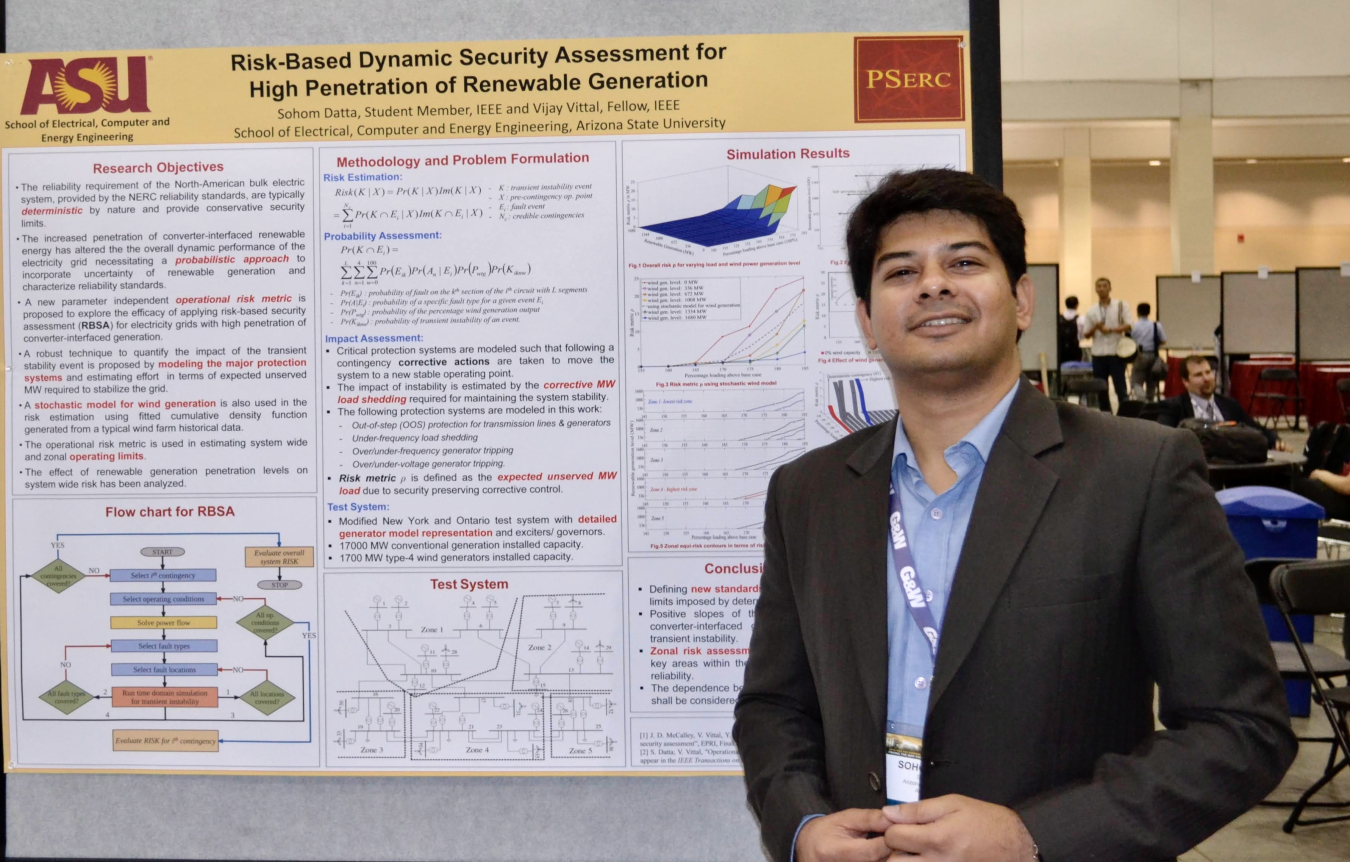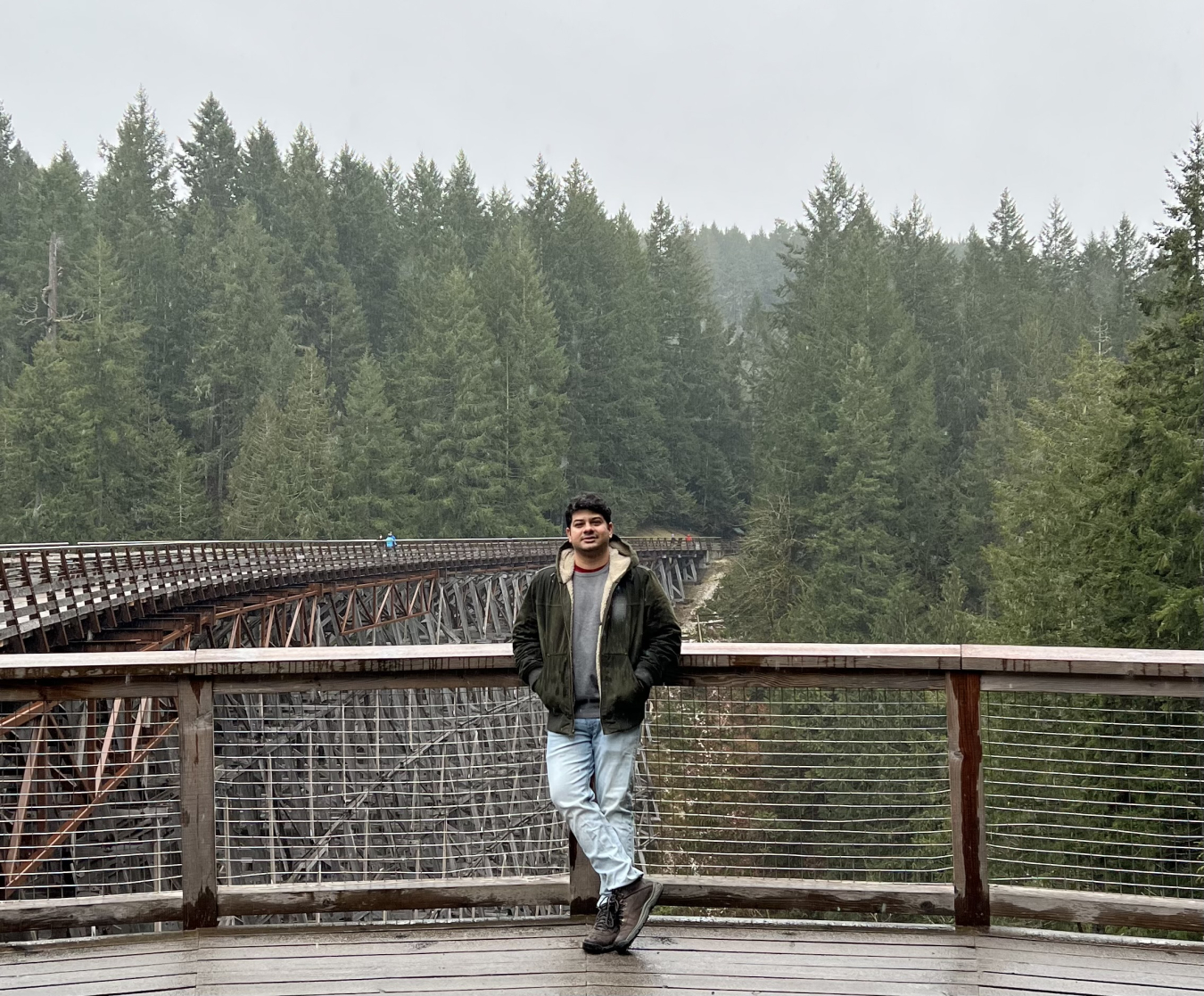Sohom Datta, a senior power systems engineer at Pacific Northwest National Laboratory, conducts research that could help identify communities that are most vulnerable to wildfires and how they could prepare to weather them with help from hydropower.
Water Power Technologies Office
September 29, 2023An eerie orange glow pulsed deep inside the dense Oregon forest. Normally, as Sohom Datta drove at night along these familiar wild roads, he could see nothing but his headlights flickering along shadowy trees, their trunks standing out from the dark of night. This time, a different but all-too-familiar flicker haunted these trees. Datta knew what it meant: Another wildfire was slowly burning through the forest, coming closer to homes and power lines.
During the 2020 and 2021 wildfires that ravaged the Pacific Northwest, Datta lived and worked in Richland, Washington. Even though no fire came close to his home, “the smog was unreal,” he said.
“That’s when we started working on the wildfire project,” said Datta, a senior power systems engineer in the Distributed Systems Group, Energy, and Environment Directorate at Pacific Northwest National Laboratory (PNNL).

Datta studies hydropower. More specifically, he looks at how this renewable powerhouse could support a clean energy grid. He’s a modeler, which means he collects and synthesizes data to predict and plan for a vast range of future electricity grid scenarios. For Datta, that means learning all there is to know about hydropower and wildfires.
“It is very difficult to explain to folks why a water power team would be working on a wildfire project,” Datta said. Let’s try anyway: Because hydropower plants are so reliable and flexible, able to generate electricity even when disconnected from the larger grid, these facilities could maintain power for critical services—like hospitals, firefighters, and water supplies—even if fires destroy transmission lines, cutting off power when communities need it most. (Many hydropower plants also store water, which firefighters can use to douse the flames.)
Datta’s forward-thinking work, which is funded by the U.S. Department of Energy’s Water Power Technologies Office (WPTO), could help identify which communities are most vulnerable to wildfires—or earthquakes, volcanic eruptions, and other extreme events—and how they could prepare to weather them, potentially with help from steady hydropower.
Datta shared how revered British naturalist, David Attenborough, influenced him to study renewable energy, why we should all be canaries, and how his forecasts could help prevent and recover from wildfires.
Ripple Effect
WPTO's Ripple Effect series features individuals whose impactful work will help advance hydropower and marine energy technologies to achieve a clean energy future.
How did you get into this niche where you’re sort of engineering the future?
I was a very curious child. I got a lot of scolding from my parents for, you know, breaking stuff. Sometimes they never knew I took the TV apart and put it back together. My brother and I used to experiment with electricity, motors, everything. And my father is also an engineer. We’d talk about his construction work and the heavy machinery he worked on.
You were clearly destined to be an engineer. What attracted you to renewable energy?
As an undergraduate student, I was studying electrical engineering and, at the same time, watching videos of David Attenborough talking about our planet. There was one episode where he showed how the savanna is shrinking and losing water. Animals are going extinct and getting smaller. In the Arctic, especially, the changes have been exponential. That was the most worrying piece: Whatever is happening is not happening in a linear fashion; it’s exponential. As an electrical engineer, I was thinking, “This is not right. How can we serve the environment?” That started my journey to make energy more sustainable.
That's a great segue into your research. How did you end up studying hydropower specifically?
My work has mostly involved modeling and simulations to predict what is going to happen as the grid evolves. When I started at PNNL, I took on a project on hydropower’s contribution to grid resiliency. That was the most important transition in my career.
We were trying to quantify how climate change might affect the future grid and what role hydropower could play. Hydropower can provide energy—that’s one of its benefits. But it provides other grid services, like filling energy gaps to keep the grid stable, restoring power when there’s an outage, or balancing the flow of electricity. Our research showed that even if hydropower makes up only 25% of the installed capacity in a grid, it provides almost 30% to 60% of the backup power following an extreme event. That was a game changer. Once we identified that, we knew hydropower was so important for grid resilience.
How did you get from that to extreme weather and other events?
After that, we extended the project to look at how compounded extreme events—like heat waves, droughts, and wildfires—could impact the grid. What we’ve seen so far is that during heat waves, depending on the time of year and snowmelt, you can get a lot of hydropower to support the grid. But if there’s a second heat wave in August, for example, we may have used up a lot of the water. Then, hydropower is still helpful, but perhaps not as helpful. And you still have to rely on other resources to support the grid.
And you do similar work on wildfires?
We wanted to figure out how a wildfire might affect the grid, too. For example, a wildfire can create very bad air quality and smoke, which can reduce solar generation by 30% to 50%. So, how do you support the grid? If the utilities shut off power lines to avoid sparking a wildfire, we could have hydropower facilities operate in an islanded fashion—running while disconnected from the larger grid—so they can provide resilience to regions affected by the air quality and smoke.
How could your models help prepare communities for these extreme events?
Extreme events won’t continue to happen forever at the same intensity or the same location. So, we’re trying to model how wildfires would evolve 40 or 50 years into the future and identify which regions would be most vulnerable. Some regions might not have alternate sources of energy and could get disconnected for days. They could plan to add energy storage, like batteries or diesel generators. Or they could convert a local stream or non-powered dam into an energy source that can provide power even if they get disconnected from the wider grid.
There seem to be so many factors involved here. Obviously predicting the future is not an easy task.
Every time we do a model, we get good information. But we also realize we need to do better. We need more multidisciplinary folks. Right now, we are working with experts in wildfires and vegetation management to learn what data we should incorporate to better predict future wildfire risk. Even predicting the paths of hurricanes—it’s not like they always head to Florida. No, they diverge. We should be simulating these events ahead of time to inform grid operators, so we can make the grid more resilient.
How do you do that—make the grid more resilient?
There are three aspects of grid resiliency: prevention, reaction, and restoration. To prevent a wildfire, we can try to predict what can cause them and inform utilities, so they can take preemptive action.
But say you could not prevent a wildfire. Now, you’re in reaction mode. We need to provide power to critical facilities and strengthen the community so they’re less vulnerable. Then, how do you provide power to restore the infrastructure and the community? That’s the slower process of rebuilding and making people feel safe again.
What advice do you have for folks who might live in a vulnerable community or who, like you, might want to do something to fight climate change?

Your community might be facing devastating climate change effects that others don’t see. If that’s you, please talk about it, so we can find a solution. We engineers only know the problems that people talk about. Going forward, we need people from all different backgrounds and expertise to fight climate change. It's not a one-person job.
It almost sounds like you and your colleagues are the proverbial canaries in the coal mine, traveling out ahead of everyone to identify potential crises, even if you’re doing that from the safety of a lab.
Everyone should be the canaries. We can only do so much. We have limited minds. We need group intelligence to fight climate change.
Catch up on WPTO’s other Ripple Effect profiles and the Office of Energy Efficiency and Renewable Energy’s Clean Energy Champions.
And stay in the know with WPTO! Receive the latest information on funding opportunities, events, and other news by subscribing to the Hydro Headlines and Water Column newsletters, as well as the comprehensive Water Wire newsletter.

